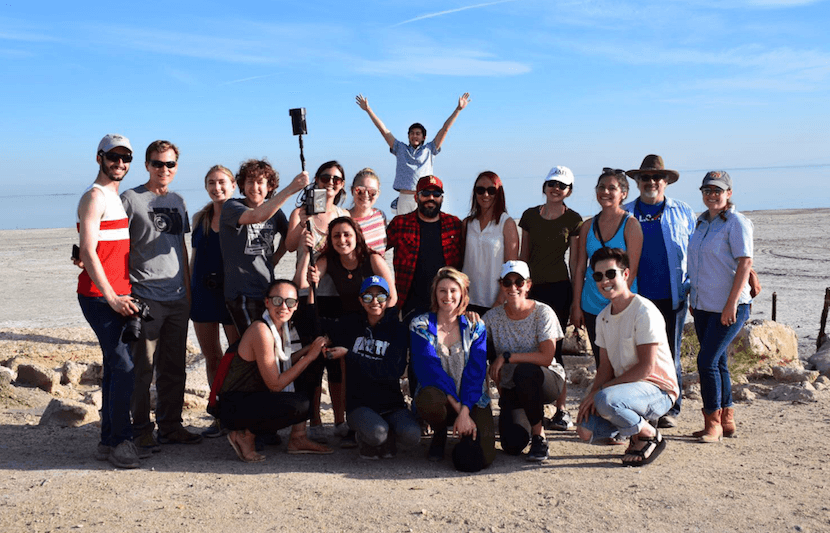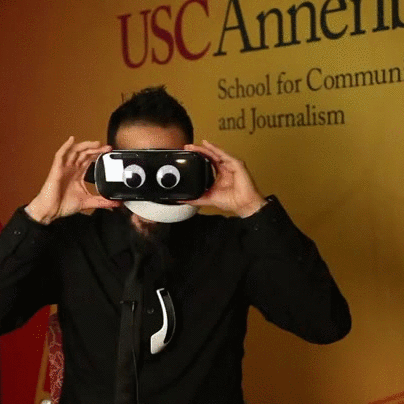Inspired by the progression of immersive storytelling, a professor at University of Southern California (USC) in Annenberg is using cutting-edge technology to prepare a new generation of journalists.
With The New York Times (NYT), National Public Radio (NPR) and other media giants beginning to use Virtual Reality (VR) and 360 degree video, it is apparent that the future of journalism is digital.
USC Annenberg School for Journalism and Communication Associate Professor Robert Hernandez is a pioneer of what will most likely be the subsequent form of journalism. Since 2009, he has spent his time teaching and preparing students with the tools to enter the workforce in the digital age. Hernandez is now continuing his third year teaching his trademark course “JOVRNALISM.”
“My entire professional career has been digital journalism, so it’s in my nature to experiment and explore new technologies and possible disruptions,” Hernandez said. “I have always been attracted to shaping best practices in these new spaces, whether it is through Web development/coding, social, mobile or now immersive.”
Hernandez’s passion is portrayed through his credentials. He taught the first ever Google Glass class at any major university and co-founded the popular online journalism Twitter hashtag #wjchat. He has worked and taught classes in VR, augmented reality (AR), mixed reality (MR), and other digital platforms.
Recently, Hernandez and his students have been working to construct award-winning comprehensive report projects. Hernandez has even granted his students the privilege of working side by side with reporters from NPR and the NYT to cover the 2017 presidential inauguration and the Women’s March in Washington, D.C. in 360-degree video.
Working with talented journalists who are already established in the field had a positive impact on Hernandez’s students and the journalists alike.
“Working together allowed for fantastic knowledge exchange,” Hernandez said. “Students saw how the NYT’s reporters got closer to the action for more engaging videos, and that had direct impact on how they captured the women’s march. With NPR, we helped introduce the use of 360/VR for news coverage. It’s a mutually beneficial relationship where we are sharing our skills and amplifying the innovative journalism.”
One of Hernandez’s classes’ comprehensive reports in 2016 called “Hell in High Water,” portrayed Houston’s potential for immense flooding and eerily predicted the future. That report made Hernandez and his students the only university team to win a Society for News Design Best Digital Design award of excellence. The team’s competition included entries from The Washington Post, the NYT and the Los Angeles Times.
In November 2017, Hernandez and his students won an Online Journalism Award in the Online News Association’s student division. The team’s work reported environmental and societal threats at the Salton Sea in Southern California.
Hernandez himself has won the 2015 Distinguished Teaching in Journalism Award from the Society of Professional Journalists for his teachings regarding immersive storytelling.
Hernandez’s active collaboration with media companies gives professionals an opportunity to learn from his techniques.
Sarah Day Owen, the consumer experience director for the Desert Sun, had a chance to work with Hernandez and his students on the Salton Sea story. She said the experience expanded the Desert Sun’s staff’s knowledge regarding VR tools.
“The Desert Sun staff working on the project — reporters Ian James and Sammy Roth, visual journalist Zoe Meyers, myself and executive editor Greg Burton — were somewhat familiar with virtual reality storytelling, but in visiting the classes at USC and being embedded with the teams while they shot VR work, we learned much more about the cameras, the editing, the shooting strategies,” Owen said in a statement.
Hernandez’s impact doesn’t stop with professional journalists. His students feel strongly that his lessons put them ahead in the field of digital journalism.
“As we all know, the digital world is growing and becoming more and more important every day,” Giovanni Moujaes, Hernandez’s former student who is now a social video producer with Los Angeles television station KTLA, said in a statement.
“Part of that is digital journalism and storytelling. Not keeping up with the pace of industry change means some journalism students will get left behind, but not the ones coming out of USC Annenberg,” he said. “Despite being only 22, I felt confident walking into a newsroom and taking command of new projects. So now I feel like I’m ahead of the curve and not simply riding it.”
Hernandez learns from his students as well, and easily finds the advantage in working with a diverse crowd of dedicated young people.
“The biggest takeaway from these projects is the power of bringing diverse students together to creatively explore new technologies and how they can be applied to journalism,” Hernandez said in a statement. “The diverse backgrounds and skill sets bring in different perspectives that are often not a factor in the industry.”
USC Annenberg has a history of being a digital journalism hub. Nonny de la Peña, nicknamed the “godmother of virtual reality” by many media outlets, helped define the program, and had an impact on Hernandez.
“I was fortunate to see Nonny de la Peña shape and define VR Journalism, since she and I got hired by USC Annenberg at the same time in 2009,” Hernandez said.
The legacy left by De la Peña and continued by Hernandez and his students will only propel in the future.
“Our goal is to be proactive with the next disruption, rather than simply be reactive,” said Hernandez.
“Whether it is VR, AR, MR or something new, the goal of the class is to constantly experiment and learn in the name of journalism. The key for us has been the collaborative experimentation. It’s not about the tech, but the collaborative culture from diverse students coming together to problem solve and prototype for journalism.”




